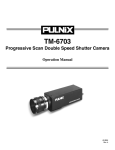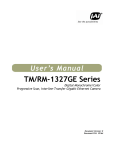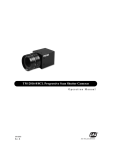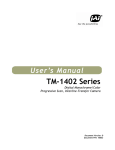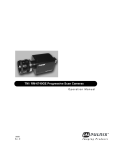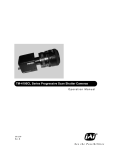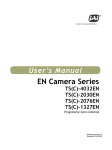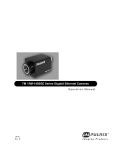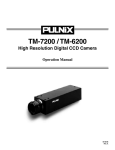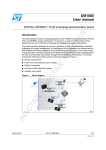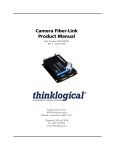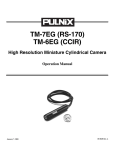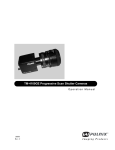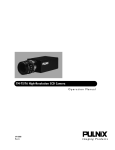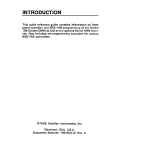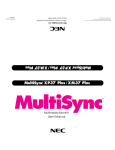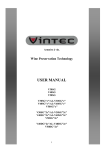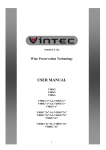Download User manual
Transcript
TM-6710/6710CL High-Speed Progressive Scanning CCD Camera Operation Manual 69-0058 Rev. D Imaging Products i Notice Page Notice The material contained in this manual consists of information that is proprietary to JAI PULNiX, Inc., and may only be used by the purchasers of the product. JAI PULNiX, Inc. makes no warranty for the use of its product and assumes no responsibility for any errors which may appear or for damages resulting from the use of the information contained herein. JAI PULNiX, Inc. reserves the right to make changes without notice. Warranty Please contact your factory representative for details about the warranty. Certifications CE Compliance The TM-6710/6710CL has been certified to conform to the requirements of Council Directive 89/336/EC for electromagnetic compatibility and to comply with the following European Standards: Immunity: EN500082-2/1995 Emissions: EN55022:1995 Class A / CISPR 22:1993 All PULNiX products bearing the CE mark have been declared to be in conformance with the applicable EEC Council Directives. However, certain factory installed options or customer requested modifications may compromise electromagnetic compatibility and prohibit use of the CE mark. Please note that the use of interconnect cables that are not properly grounded and shielded may affect CE compliance. Contact PULNiX Applications Engineering Department for further information regarding CE compliance. FCC This equipment has been tested and found to comply with the limits for a Class A digital device, pursuant to Part 15 of the FCC Rules. These limits are designed to provide reasonable protection against harmful interference when the equipment is operated in a commercial environment. This equipment generates, uses and can radiate radio frequency energy and, if not installed and used in accordance with the instruction manual, may cause harmful interference to radio communications. Operation of this equipment in a residential area is likely to cause harmful interference in which case the user will be required to correct the interference at his own expense. WARNING Changes or modifications to this unit not expressly approved by the party responsible for FCC compliance could void the user’s authority to operate the equipment. S UL ® O C I AT I O N ISO-9001 TE ED R I SS RM FILE # A3942 REG MEMBER A FI TED IM A MA O ING G AU T TM-6710/6710CL Operation Manual Printing: August 30, 2004 JAI PULNiX, Inc. 1330 Orleans Drive Sunnyvale, CA 94089 Tel: (408) 747-0300 Tel: (800) 445-5444 Fax: (408) 747-0880 E-mail: [email protected] www.jaipulnix.com JAI PULNiX INC. TM-6710/6710CL High-Speed Progressive Scanning CCD Camera ii Table of Contents 1 Introduction . . . . . . . . . . . . . . . . . . . . . . . . . . . . . . . . . . . . 1 1.1 1.2 1.3 1.4 Product Description . . . . . . . . . . . . . . . . . . . . . . . . . . . . . . . . . . Features. . . . . . . . . . . . . . . . . . . . . . . . . . . . . . . . . . . . . . . . . . . . Applications . . . . . . . . . . . . . . . . . . . . . . . . . . . . . . . . . . . . . . . . System Configuration. . . . . . . . . . . . . . . . . . . . . . . . . . . . . . . . . 1 1 2 3 2 Installation . . . . . . . . . . . . . . . . . . . . . . . . . . . . . . . . . . . . . 5 2.1 Getting Started . . . . . . . . . . . . . . . . . . . . . . . . . . . . . . . . . . . . . . 5 2.1.1 Unpacking Instructions . . . . . . . . . . . . . . . . . . . . . . . . . . . . . . . . . . . . . 5 2.1.2 Components List . . . . . . . . . . . . . . . . . . . . . . . . . . . . . . . . . . . . . . . . . . 5 2.1.3 Accessories and Options. . . . . . . . . . . . . . . . . . . . . . . . . . . . . . . . . . . . 5 2.2 Camera Setup . . . . . . . . . . . . . . . . . . . . . . . . . . . . . . . . . . . . . . . 6 2.2.1 2.2.2 2.2.3 2.2.4 Pin Configurations . . . . . . . . . . . . . . . . . . . . . . . . . . . . . . . . . . . . . . . . 6 Power Supply and Power Cable Setup . . . . . . . . . . . . . . . . . . . . . . . . . 8 RS-232 Cables and Connectors (TM-6710 only) . . . . . . . . . . . . . . . . 10 Attaching the Video Output (Analog Output on TM-6710 Only) . . . . . . . . . . . . . . . . . . . . . . . . . . . . . . . . . 10 2.2.5 Attaching the Camera Lens. . . . . . . . . . . . . . . . . . . . . . . . . . . . . . . . . 11 2.2.6 Back focusing the Lens. . . . . . . . . . . . . . . . . . . . . . . . . . . . . . . . . . . . 11 3 Operation . . . . . . . . . . . . . . . . . . . . . . . . . . . . . . . . . . . . . 12 3.1 Dual-Tap Video Output . . . . . . . . . . . . . . . . . . . . . . . . . . . . . . 12 3.2 Rear Panel. . . . . . . . . . . . . . . . . . . . . . . . . . . . . . . . . . . . . . . . . 12 3.2.1 Mode Control Switches (TM-6710) . . . . . . . . . . . . . . . . . . . . . . . . . . 14 3.3 Modes of Operation . . . . . . . . . . . . . . . . . . . . . . . . . . . . . . . . . 14 3.3.1 3.3.2 3.3.3 3.3.4 3.3.5 3.3.6 3.3.7 Shutter Operation . . . . . . . . . . . . . . . . . . . . . . . . . . . . . . . . . . . . . . . . 14 External Synchronization . . . . . . . . . . . . . . . . . . . . . . . . . . . . . . . . . . 15 Asynchronous Reset with Shutter. . . . . . . . . . . . . . . . . . . . . . . . . . . . 15 Partial Scan Mode. . . . . . . . . . . . . . . . . . . . . . . . . . . . . . . . . . . . . . . . 18 Integration. . . . . . . . . . . . . . . . . . . . . . . . . . . . . . . . . . . . . . . . . . . . . . 18 Progressive scanning . . . . . . . . . . . . . . . . . . . . . . . . . . . . . . . . . . . . . 19 RS-232C (or optional RS-485) Control and Camera Link Serial Communication. . . . . . . . . . . . . . . . . . . . . . . . . . . . . . . . 19 3.3.8 Video Output. . . . . . . . . . . . . . . . . . . . . . . . . . . . . . . . . . . . . . . . . . . . 25 3.3.9 Timing. . . . . . . . . . . . . . . . . . . . . . . . . . . . . . . . . . . . . . . . . . . . . . . . . 25 4 Camera Timing Charts . . . . . . . . . . . . . . . . . . . . . . . . . . . 27 5 Troubleshooting . . . . . . . . . . . . . . . . . . . . . . . . . . . . . . . . 31 5.1 Problems and Solutions . . . . . . . . . . . . . . . . . . . . . . . . . . . . . . 31 5.1.1 5.1.2 5.1.3 5.1.4 Symptom: No Video . . . . . . . . . . . . . . . . . . . . . . . . . . . . . . . . . . . . . . 31 Symptom: Dark Video . . . . . . . . . . . . . . . . . . . . . . . . . . . . . . . . . . . . 31 Symptom: Non-synchronized Video. . . . . . . . . . . . . . . . . . . . . . . . . . 31 Symptom: RS-232 Non-communication . . . . . . . . . . . . . . . . . . . . . . 31 5.2 Information and Support Resources . . . . . . . . . . . . . . . . . . . . . 32 6 Appendix . . . . . . . . . . . . . . . . . . . . . . . . . . . . . . . . . . . . . 33 6.1 Specifications . . . . . . . . . . . . . . . . . . . . . . . . . . . . . . . . . . . . . . 33 6.2 Block Diagrams . . . . . . . . . . . . . . . . . . . . . . . . . . . . . . . . . . . . 36 TM-6710/6710CL High-Speed Progressive Scanning CCD Camera iii List of Figures FIGURE 1. TM-6710 System Configuration . . . . . . . . . . . . . . . . . . . . . . . . . . . . . . . . . . 3 FIGURE 2. TM-6710CL System Configuration. . . . . . . . . . . . . . . . . . . . . . . . . . . . . . . . 4 FIGURE 3. 51-Pin Connector . . . . . . . . . . . . . . . . . . . . . . . . . . . . . . . . . . . . . . . . . . . . . 7 FIGURE 4. Camera Link Connector. . . . . . . . . . . . . . . . . . . . . . . . . . . . . . . . . . . . . . . . . 7 FIGURE 5. MDR 26-Pin Connector (0226-622VC) . . . . . . . . . . . . . . . . . . . . . . . . . . . . 8 FIGURE 6. 12P-02S Power Cable . . . . . . . . . . . . . . . . . . . . . . . . . . . . . . . . . . . . . . . . . . 9 FIGURE 7. RS-232 Serial Communication Cable . . . . . . . . . . . . . . . . . . . . . . . . . . . . . 10 FIGURE 8. Rear Panel Layout (TM-6710) . . . . . . . . . . . . . . . . . . . . . . . . . . . . . . . . . . 12 FIGURE 9. Rear Panel Layout (TM-6710CL) . . . . . . . . . . . . . . . . . . . . . . . . . . . . . . . . 13 FIGURE 10. External Pulse Width Mode. . . . . . . . . . . . . . . . . . . . . . . . . . . . . . . . . . . . . 16 FIGURE 11. Internal Fast Reset Mode . . . . . . . . . . . . . . . . . . . . . . . . . . . . . . . . . . . . . . . 17 FIGURE 12. Internal Slow Reset Mode . . . . . . . . . . . . . . . . . . . . . . . . . . . . . . . . . . . . . . 18 FIGURE 13. Async Reset Image Capture . . . . . . . . . . . . . . . . . . . . . . . . . . . . . . . . . . . . 25 FIGURE 14. Integrated Image Capture . . . . . . . . . . . . . . . . . . . . . . . . . . . . . . . . . . . . . . 25 FIGURE 15. TM-6710 Physical Dimensions . . . . . . . . . . . . . . . . . . . . . . . . . . . . . . . . . . 34 FIGURE 16. TM-6710CL Physical Dimensions . . . . . . . . . . . . . . . . . . . . . . . . . . . . . . . 34 FIGURE 17. Glass Specifications. . . . . . . . . . . . . . . . . . . . . . . . . . . . . . . . . . . . . . . . . . . 35 FIGURE 18. TM-6710 Spectral Response . . . . . . . . . . . . . . . . . . . . . . . . . . . . . . . . . . . . 35 FIGURE 19. TM-6710 Block Diagram . . . . . . . . . . . . . . . . . . . . . . . . . . . . . . . . . . . . . . 36 FIGURE 20. TM-6710CL Block Diagram . . . . . . . . . . . . . . . . . . . . . . . . . . . . . . . . . . . . 36 TM-6710/6710CL High-Speed Progressive Scanning CCD Camera August 30, 2004 TM-6710/6710CL High-Speed Progressive Scanning CCD Camera Operation Manual 1 Introduction 1.1 Product Description The TM-6710* is a high-resolution monochrome CCD camera with “quad speed” 120FPS dual-tap, dual-channel digital output. 1.2 Features • Three scanning modes - Non-interlace quad speed scanning (484 active lines at 120Hz or 60Hz (selectable)) - 200 lines partial scanning (at 236Hz) - 100 lines partial scanning (at 300Hz) • Full frame electronic shutter The substrate drain electronic shutter captures images at various speeds without any smearing. The electronic shutter works in all there scanning modes except slow speed at partial scanning. • 1/2" progressive scan interline transfer CCD Advantages include: - High resolution (648 H x 484 V) active pixels for very high speed and image quality. - Square pixels (9.0 x 9.0 µm). Precise dimensional measurement ability. - High speed electronic shutter capability offering high dynamic resolution of moving objects, as well as electronic iris control. This eliminates the need for a mechanical shutter. *. Unless specifically mentioned, all information in this manual is relevant to both the TM-6710 and TM-6710CL cameras. TM-6710/6710CL High-Speed Progressive Scanning CCD Camera Page 2 Introduction - Progressive scan, which eliminates interlace deterioration of the image while offering an easy-to-use computer interface. - High sensitivity and low noise at fast scanning. Can drive faster than 25 MHz pixel clock rate. Excellent S/N ratio (>45 dB, 8-bit typical). Built-in micro lens. - Partial scan capability, which allows 100 and 200 lines of partial scan up to 300Hz scanning. • Asynchronous reset The TM-6710 captures an image using asynchronous reset. This feature is especially important for applications requiring the capture of images of moving objects at the precise location in the field of view, such as a belt conveyer, fast event observation and still picture capture. An asynchronously resettable frame grabber is required to capture the async reset images. • Digital output The TM-6710 has a pair of 8-bit A/D converters, and a line buffer that generates 16-bit, 25MHz dual channel digital output. The digital output is standard RS-644 format with LDV, FDV and clock output for standard frame grabbers or Camera Link. The Camera Link model is called the TM6710CL. • RS-232C (or RS-485) control External computer control allows the operator to remotely adjust the following functions: clock speed, shutter, gain, A/D reference and scan format. Camera Link controls the same functions via a Camera Link serial communication. • VGA display output Because progressive scan cameras are not in TV format, the display of the video signal can only be achieved by using a frame grabber and computer. The VGA output of the TM-6710 scans the FIFO memory read out at 120Hz at 50.98 MHz pixel clock (or 60 Hz) non-interlace (multiplexed output). • Miniaturized, lightweight and rugged All PULNiX cameras are built with the same design principles: Solid state technology; miniaturization; application-specific features such as custom design, remote imagers, special functions for various application needs; and design robust enough even for military applications. • Warranty Please contact your factory representative for details about the warranty. 1.3 Applications Designed for speed and functional versatility, the TM-6710 is ideal for applications such as high speed image capturing, machine vision, computer graphics, gauging, avionics, microscopy, character and fine pattern recognition, document reading and high-end surveillance. TM-6710/6710CL High-Speed Progressive Scanning CCD Camera Page 3 Introduction 1.4 System Configuration FIGURE 1. TM-6710 System Configuration Figure 1 below presents a typical system configuration for the TM-6710 camera. Please see “Power Supply and Power Cable Setup” on page 7 for info on power supplies. Ext. Sync Power Trigger Analog video SHUTTER B 9 3 4 56 CD E 01 2 A UP VIDEO 4 5 6 2 3 78 0 1 78 9 POWER DWN MODE DIGITAL RS-232 P/N: CS-232-B912 Multi Sync Analog Monitor Digital cable: P/N 50DG-02LP Frame Grabber Board FIGURE 2. TM-6710CL System Configuration Figure 2 below presents a typical system configuration for the TM-6710CL camera. Please see “Power Supply and Power Cable Setup” on page 7 for information on power supplies. PD-12 (series) power supply 12P-02S External Sync. Power Trigger Analog video POWER 26CL-02-26 CAMERA LINK TM-6710/6710CL High-Speed Progressive Scanning CCD Camera Page 4 Installation 2 Installation The following instructions are provided to help you to set up your video camera system quickly and easily. We suggest that you read through these instructions prior to unpacking and setting up your camera system. 2.1 Getting Started 2.1.1 Unpacking Instructions We recommend that you save the original packing cartons for the cameras in case you need to return or exchange an item. We also recommend that any equipment being sent to another location for field installation be bench tested to assure that everything works together properly. 2.1.2 Components List Please begin by checking your order against the Components List (below) to assure that you have received everything as ordered, and that nothing has been overlooked in the packing materials. If any item is missing, please contact your PULNiX representative immediately. • TM-6710 or TM-6710CL camera • Tripod mount • TM-6710 /TM-6710CL manual (if ordered) • Warranty card • Document information card 2.1.3 Accessories and Options Following is a list of additional accessories or equipment that may be recommended or required for your particular application. Please check with your PULNiX representative prior to the installation of your video system to determine what you might need. • RS-232 cable (Part #CS-232-B912 for the TM-6710 camera) • Digital cable (Part #50DG-02LP for the TM-6710 camera. Contact the factory for frame-grabber specific cables.) • PD-12UUP power supply or PD-12UU power supply with 12P-02S cable • 26CL-02-16 Camera Link cable (for TM-6710CL camera) TM-6710/6710CL High-Speed Progressive Scanning CCD Camera Page 5 Installation 2.2 Camera Setup 2.2.1 Pin Configurations 2.2.1 (a) 12-Pin Connector (TM-6710) The TM-6710 has a 12-pin connector for power input. Pin #1 is Ground and Pin #2 is +12V DC. The other pins handle a number of other input and output functions, as detailed below. Pin 1 2 3 4 5 6 2.2.1 (b) Description GND (Power) +12V DC GND (Analog) Video Out GND (Digital) VINIT In Pin 7 8 9 10 11 12 Description VD In N/C HD In RXD (RS-232) Integration TXD (RS-232) 1 2 3 9 11 4 8 10 7 12 5 6 12-Pin Connector (TM-6710CL) The TM-6710CL has a 12-pin connector for power input. Pin #1 is ground and Pin #2 is +12V DC. The pinout table is shown below. For the TM-6710CL, serial communication camera control is done via the Camera Link connector on the rear panel of the camera. Pin 1 2 3 4 Description GND (Power) +12V DC GND (Analog) Video Out Pin 7 8 9 10 Description VD In N/C HD In 5 GND (Digital) 11 6 VINIT In† 12 Integration† TXD* RXD* *. Optional TTL serial communications. †. VINIT and Integration can be controlled via Camera Link. When Camera Link is connected for these uses, do not use the 12-pin connector inputs. TM-6710/6710CL High-Speed Progressive Scanning CCD Camera Page 6 Installation 2.2.1 (c) 51-Pin Connector The TM-6710 has a 51-pin connector for RS-644 digital output (using B channel digital output to configure single channel). FIGURE 3. 51-Pin Connector 18 1 35 19 51 2.2.1 (d) 36 Pin# Description Pin# Description Pin# Description 1 A0+ 18 CLK+ 35 CLK- 2 B0+ 19 A0- 36 GND 3 A1+ 20 B0- 37 VCC (jumper) 4 B1+ 21 A1- 38 VCC (jumper) 5 A2+ 22 B1- 39 EXT. HD 6 B2+ 23 A2- 40 TXD 7 A3+ 24 B2- 41 LPULSE 8 B3+ 25 A3- 42 RXD 9 A4+ 26 B3- 43 VINIT INTEG 10 B4+ 27 A4- 44 11 A5+ 28 B4- 45 EXP- 12 B5+ 29 A5- 46 EXP+ 13 A6+ 30 B5- 47 LDV- 14 B6+ 31 A6- 48 LDV+ 15 A7+ 32 B6- 49 FDV- 16 B7+ 33 A7- 50 FDV+ 17 GND 34 B7- 51 GND Camera Link Connector The TM-6710CL has a 26-pin connector on the rear panel to output Camera Link data. The connector pinout is shown in Figure 4 below. FIGURE 4. Camera Link Connector 13 1 13 12 11 26 25 24 26 10 23 9 8 7 6 5 4 3 2 1 22 21 20 19 18 17 16 15 14 14 TM-6710/6710CL High-Speed Progressive Scanning CCD Camera Page 7 Installation FIGURE 5. MDR 26-Pin Connector (0226-622VC) MDR 26-Pin Connector (0226-622VC) 2.2.2 Pin# Description Pin# Description 1 GND (shield) 14 GND (Shield) 2 X0- 15 X0+ 3 X1- 16 X1+ 4 X2- 17 X2+ 5 Xclk- 18 Xclk+ 6 X3- 19 X3+ 7 SerTC+ 20 SerTC- 8 SerTFG- 21 SerTFG+ 9 VINIT (CC1-) 22 VINIT (CC1+) 10 INTEG (CC2+) 23 INTEG (CC2-) 11 CC3- 24 CC3+ 12 CC4+ 25 CC4- 13 GND (shield) 26 GND (Shield) Power Supply and Power Cable Setup PULNiX recommends the following power supply: PD-12UUP 110V AC/12V DC 1.2A power supply If you are providing power through the 12-pin connector, the PD-12UUP power supply is available with the 12-pin mating connector already attached to the leads from the power supply. The PD-12UU power supply can be connected directly to the PULNiX power cable or via a terminal strip. If you choose direct wiring, note the following: • The lead ends must be twisted together and tin-soldered for strength and electrical continuity. • Use shrink tubing or a similar insulator to prevent exposed leads from touching. • The +12V lead is marked with a red stripe or white lettering; be sure not to reverse the leads. • All connections must be properly insulated to prevent shorting. If using PULNiX power cables, such as the 12P-02S, etc., please refer to the pin-out diagram. The color-coded leads use Gray for Ground and Yellow for +12V DC. FIGURE 6. 12P-02S Power Cable +12 V Male GND (Gray) Power (Yellow) Video Out (Red Coax) HD In (White Coax) VD In (Black Coax) } Monitor Frame Grabber Note: Make sure that the unused leads are not touching and that there is no possibility that the leads could short due to exposed wires. TM-6710/6710CL High-Speed Progressive Scanning CCD Camera Page 8 Installation If you are building your own power cables, consult the pin-out for the camera purchased. Connect the Ground and +12V power leads of the PC-12P power connector to Pin #1 and Pin #2, respectively. Remember that power must be DC regulated, and of sufficient current to properly power the camera. Attach the power cable to the connector. The 12-pin connector is keyed and will only fit in one orientation. Rotate the connector while applying slight pressure until the keyways line up. Press the connector into place until it is firmly seated. You may now plug the power cord into the 110V AC socket and power up the camera. 2.2.3 FIGURE 7. RS-232 Cables and Connectors (TM-6710 only) RS-232 Serial Communication Cable 2000 ± 20mm To: Computer Com Port MALE 1 9 2 3 4 10 11 1 7 12 5 6 8 6 5 To: Power & Sync Box To: Camera FEMALE 265mm ± 5mm Part # CS-232-B912 12-Pin Male Connector 12-Pin Female Connector Pin# Description Pin# Description 1 2 3 4 5 6 7 8 9 10 11 12 GND +12V GND Video Out GND VINIT VD In N/C HD In N/C INTEG N/C 1 2 3 4 5 6 7 8 9 10 11 12 GND +12V GND Video Out GND VINIT VD In N/C HD In RXD INTEG TXD TM-6710/6710CL High-Speed Progressive Scanning CCD Camera 9 Page 9 Installation D-Sub 9-Pin Connector (ITEM 15-1007) PIN 1 PIN 2 TO COMPUTER COM PORT PIN 3 To pin #12 of 12-pin female connector To pin #10 of 12-pin female connector PIN 4 PIN 5 To pin #5 of 12-pin female connector PIN 6 PIN 7 PIN 8 PIN 9 2.2.4 Attaching the Video Output (Analog Output on TM-6710 Only) Connect a BNC cable to the output from the camera and the input to your system (frame grabber analog input). The input of the system or monitor should be balanced for 75ohms termination. Standard RG-59 type coaxial cable should carry a full video signal for up to 100 feet. If you want to output the video, input the power, and sync to a camera over a single cable, you can use a PULNiX multi-conductor cable, such as the 12P-02S. The mini coaxial leads in PULNiX multiconductor cables are designed for short runs of no longer than 100 feet. Note: Make sure that no extraneous wires are visible which could cause a short. Note: For digital output, see Section 3.3.9 on page 23. 2.2.5 Attaching the Camera Lens The TM-6710 camera accepts standard C-mount lenses. To attach the C-mount lens to the camera, carefully engage the threads and rotate the lens clockwise until it firmly seats on the mounting ring. Do not force the lens if it does not seat properly. Please note that some lenses with extremely long flangebacks may exceed the mounting depth of the camera. 2.2.6 Back-Focusing the Lens To backfocus the TM-6710 camera, follow the steps below: 1. Attach a C-mount lens in the lens mount. Be sure that the lens is properly mounted. 2. Set the lens focus to infinity (if the lens is a manual iris, set the iris to a high f-stop while still retaining a well-lighted image). 3. Obtain the best focus possible at this setting, then loosen two of the three miniature hex head set screws locking the focus ring in place. 4. Now turn the entire lens and focus ring assembly back and forth until the best image is obtained. 5. Tighten the focus ring set screws. Your backfocus is now set. TM-6710/6710CL High-Speed Progressive Scanning CCD Camera Page 10 Operation Operation 3.1 Dual-Tap Video Output The TM-6710CL uses a dual-tap output for its fast frame readout. At the same horizontal clock cycle, line 1 and all odd lines go to channel A, and line 2 and all even lines go to channel B. Vertical shift registers move twice per horizontal blanking period. Lines are grouped in twos, so that 1 and 2, and 3 and 4, and so on, are output from channel A and B simultaneously. V shift registers Photodiode 5 4 3 2 Lines 1 CCD output Channel B (Even) Channel A (Odd) Horizontal shift registers 3.2 Rear Panel FIGURE 8. Rear Panel Layout (TM-6710) Shutter SHUTTER 6 78 B A CD 12-Pin Power E0 1 2 9 78 UP VIDEO 0 1 3 4 56 Up/down switch (mode control) 9 2 3 Analog video output connector 4 5 3 DWN MODE POWER Mode selection switch 51-pin digital output connector DIGITAL TM-6710/6710CL High-Speed Progressive Scanning CCD Camera Page 11 Operation FIGURE 9. Rear Panel Layout (TM-6710CL) 12-Pin Power POWER Camera Link connector CAMERA LINK TM-6710/6710CL High-Speed Progressive Scanning CCD Camera Page 12 Operation 3.2.1 Mode Mode Control Switches (TM-6710) Control Switch Up/Down Switch 0 Normal mode 1 Gain control (A/B) up - increase gain of Ch. A down - decrease gain of Ch. A 2 Gain (A/B) fine tune up - increase gain of Ch. A down - decrease gain of Ch. A, while decrease/increase gain of Ch. B, at 5:1 ration 3 Main Vref control up - increase gain of Ch. A down -decrease A/D voltage reference of Ch. A & Ch. B 4 Vref balance control up - increase gain of Ch. A down - increase/decrease A/D voltage reference of Ch. A, while decrease/increase gain of Ch. B 5 Gain selection up: 9dB down: 12dB 6 Gain selection up: 18dB down: 22dB 7 Clock selection up: 120Hz down: 60Hz 8 Async/Manual shutter up: Manual down: Async 9 Factory set recall up/down - recall only A Power up (recall or save) up: recall down: save B-C User page storage (store user settings) up: recall down: save D Direct shutter up - increase manual shutter speed down - decrease manual shutter speed E Partial scan up: 100 lines down: F Partial scan up: normal scan down: 200 lines 3.3 Modes of Operation 3.3.1 Shutter Operation The TM-6710 has a substrate drain electronic shutter mechanism which provides a superb picture at various speeds without smearing. Manual shutter speed control can be selected at 1/250, 1/500, 1/1,000, 1/2,000, 1/4,000, 1/8,000, 1/16,000 or 1/32,000 sec. rate. Note: Some slow speed shutter rates will not apply to partial scanning. TM-6710/6710CL High-Speed Progressive Scanning CCD Camera Page 13 Operation 3.3.2 External Synchronization The TM-6710 can take external HD and VD for phase locking. The internal PLL will take external HD and lock with the CCD HD. (The CCD HD frequency is half of the analog video output HD.) Example: Ext. HD = 30.49KHz, VD will be 120Hz and Master Clock will be 50.98MHz. INSIDE CAMERA OUTSIDE CAMERA 1µF Ext HD (or Ext VD) C1 4.7k R1 External Sync Input Schematic The internal sync generator will take external VD to generate internal VD. External VD frequency should be the same as the frame rate. 3.3.3 Asynchronous Reset with Shutter To activate the asynchronous reset mode, use the Mode control switch on the back panel of the camera (TM-6710). The asynchronous trigger input (VINIT) is applied to pin #6 of the 12-pin connector (TM6710) or pins #9 and #22 of the Camera Link connector (TM-6710CL). The TM-6710’s asynchronous reset is flexible and takes external HD for phase 0 locking. Applying a VINIT pulse resets the camera’s scanning and purging of 1 9 the CCD. When async reset pulse (VINIT) is applied to High state (+5V) with 2 8 dial switch select from 1 to 9, the TM-6710’s asynchronous camera discharges 3 7 the photo charges into the substrate drain although the camera is still running on 4 6 5 its sync timing and only outputs captured video. When the negative going reset pulse is applied, the camera will latch the falling edge to its next horizontal Shutter Control Switch drive and reset vertical sync timing immediately. Then it starts integrating for the period of shutter control set by either an external pulse width pulse or internal shutter control. Therefore the horizontal phase will not be interrupted. The TM-6710 asynchronous camera will output one frame of shuttered video after reset. TABLE 1. Shutter Control Set Manual Mode 0 Async Reset Mode No Shutter (1/120) No Shutter (1/120) 1 1/250 128H 1/32,000 1.0H 2 1/500 64H 1/16,000 2.0H 3 1/1,000 32H 1/12,000 3.0H 4 1/2,000 16H 1/8,000 4.0H 5 1/4,000 8.0H 1/4,000 8.0H 6 1/8,000 4.0H 1/2,000 16H 7 1/12,000 3.0H 1/1,000 32H 8 1/16,000 2.0H 1/500 64H 9 1/32,000 1.0H Shutter determined by pulse width There are three modes to control the asynchronous reset and shutter speed: • External Pulse Width Control Mode TM-6710/6710CL High-Speed Progressive Scanning CCD Camera Page 14 Operation • Internal Fast Reset Mode • Internal Slow Reset Mode Mode 0: Async Mode 1-4: Async Mode: 5-8: Async Mode 9: 3.3.3 (a) Normal Mode Fast Mode Slow Mode External pulse width control mode External Pulse Width Control Mode The TM-6710 can be reset with external reset pulse (VINIT). Set the dial switch to “9.” Apply a pulsewidth control VINIT signal generated from an external 100Ω (VINIT) event trigger to the camera. The internal reset pulse R2 will be latched to Hd and at 5th HD timing from the 4.7k R1 external pulse leading edge (negative going edge). The CCD discharge pulse will be generated to clear the VINIT Input Schematic images. The internal VINIT will be generated at the following edge (positive going edge) of the external pulse, resetting the internal timing including the video sync. The shutter speed is the same as the external pulse width, but the integration delays 5H from the leading edge. For the immediate reset option, please contact PULNiX. FIGURE 10. External Pulse Width Mode External Pulse Width VINIT Min 1.5H Hd 1 2 3 4 5 6 7 8 9 10 11 12 13 14 15 Internal VINIT 3H 6H Transfer Gate Pulse 7H X Exposure Time Discharge pulse EXPOUT Exposure Time X Composite Video For the progressive format, one frame of video output will start from the rising edge of the pulse width control. At async mode with external pulse input high, the video output will be disabled as the camera continues discharging the CCD image, providing black video only. TM-6710/6710CL High-Speed Progressive Scanning CCD Camera Page 15 Operation This feature is especially important in capturing moving objects at the precise location of the field of view, such as belt conveyer, fast event observation and still picture capturing. 3.3.3 (b) Internal Fast Reset Mode The video signal has no delay from the reset timing. Shutter speed range is 1/8,000 to 1/31,000 sec. Select a dial switch setting from “1” to “4.” When the fast reset mode is selected, the camera resets with internal VINIT timing, which is latched to HD, and video output is also synchronized with internal VINIT timing without further delay. The shutter speed is controlled by the dial switch. FIGURE 11. Internal Fast Reset Mode External pulse (VINIT) min. 2H Hd 1 2 3 4 5 Internal Vinit 5H Transfer Gate Pulse Exposure Time Purge pulse (discharge) Composite Video 3.3.3 (c) Internal Slow Reset Mode The speed control ranges from 1/120 to 1/4,000 sec. With the internal slow reset mode selected, the camera operates the reset and shutter in the same way as the external pulse width control mode. When the external VINIT pulse is applied, internal VINIT is latched to HD and the second internal VINIT signal is delayed to set up the shutter speed period. The shutter speed is controlled by the dial switch from “5” to “8.” Video output timing starts right after the internal VINIT. For the timing of the delayed internal reset, LPULSE output of the 51-pin connector can be used. TM-6710/6710CL High-Speed Progressive Scanning CCD Camera Page 16 Operation FIGURE 12. Internal Slow Reset Mode Pulse (VINIT) min 2H Hd 1 2 3 4 5 6 7 8 9 10 Internal Vinit External X 5H Transfer Gate Pulse 7H Discharge pulse Exposure Time Composite Video 3.3.4 Partial Scan Mode A key advantage of the TM-6710 is the partial scan mode, which provides up to 300Hz frame rate output. 200 line partial scan is output at 236Hz. 100 line partial scan is output at 300Hz. SHUTTER 6 78 9 78 B A E0 1 2 3 4 56 CD 2 3 UP VIDEO Normal mode: F UP 120 Hz progressive scan 200 line scan: F DWN 236 Hz progressive scan 100 line scan: E UP 300 Hz progressive scan 0 1 4 5 9 POWER DWN MODE DIGITAL 3.3.5 Integration Integration is activated by keeping INTEG control as active low. Integ is #11 of the 12-pin connector for the TM-6710, (TTL) and #10 and 23 of the Camera Link connector for the TM-6710CL (LVDS). During low, the TM-6710 series keeps integrating and, upon the rising edge of the INTEG control pulse, outputs the frame. During integration, the signal processing keeps optical black levels as the reference black video to clamp video levels. This has the result of cancelling out thermal noise during the integration period. TM-6710/6710CL High-Speed Progressive Scanning CCD Camera Page 17 Operation 3.3.6 Progressive Scanning The TM-6710 uses a state-of-the-art CCD called a “Progressive scanning interline transfer CCD” which scans all lines sequentially from top to bottom at one frame rate 120 Hz or (60 Hz) with dual channel output. Like a non-interlace computer screen, it generates a stable crisp image without alternating lines and provides full vertical TV resolution of 484 active lines. The interline transfer architecture is also important to generate simultaneous shuttering. This is different from full frame transfer architecture which requires a mechanical shutter or strobe light in order to freeze the object motion. The TM-6710 outputs the progressive scanned image with an electronic shutter in two different formats: 1. Progressive scanning quad speed output (normal mode) Straightforward signal output equivalent to non-interlace VGA format (120 Hz). This is real-time CCD output through Camera Link, digital RS-644 output, and normal analog video processing into 75ohms 1Vp-p output format. 2. Partial scanning output (Rear switch.... 100 lines,.... 200 lines) TM-6710 only By setting the switch to 100 line partial scan, the TM-6710 outputs 100 lines of video. It repeats the same rate with the fast dump blanking. The asynchronous reset and electronic shutter functions are maintained at each partial scan. When 200 line partial scan is selected, 200 lines of video are output. The partial scan maintains the same resolution as full progressive scan, although with a narrower field of view. It also maintains the same image center between partial scan and normal images. 3.3.7 RS-232C (or Optional RS-485) Control and Camera Link Serial Communication The TM-6710’s built-in microcomputer chip (CPU) can be controlled by an external RS-232C interface. The internal CPU controls TM-6710 operation mode and DSP parameter changes. Contact PULNiX for the TM-6710 software diskette. Camera Link control is implemented via Camera Link serial communication. We recommend that you use PULNiX control software (.dll), part number 690062. 3.3.7 (a) RS-232C Communication Default Condition Parity: None Data: 8-bit STOP: 1-bit Baud rage: 9600 bps If other communication conditions are required, please contact PULNiX. TM-6710/6710CL High-Speed Progressive Scanning CCD Camera Page 18 Operation 3.3.7 (b) RS-232C Control Commands External RS-232C (or optional RS-485) computer control allows the operator to remotely adjust the following functions: clock speed, shutter, gain, A/D reference and scan format. The control commands are detailed below. Note: RS-232 control will override the rear panel switch control. (TM-6710 only) The TM-6710 command package begins with “.” (Start of Text = 3AH), and is then followed by the Command Code (C.C...one alphabet), Command option parameter and CR (End of Text = 0DH) to end. When a packet is received by the TM-6710 (ETX:03H is detected), it reads the internal packet of the receiver buffer. If it is the correct packet, then it processes the parameters based on the command. When the process is completed, it sends a completion signal (AK packet). If an error is detected, a No-go signal (NK packet) is sent back and it disregards the packet signal in the buffer. When an NK packet is sent from the TM-6710, the host must correct the error and resend the packet. Example: Executing manual shutter control #2. The C.C. packet is sent as follows: “:”, “S”, “M”, “2”, CR 3AH, 53H, 4DH, 32H, 0DH where “S”.....Shutter control command mode “M”.....Manual mode The TM-6710 will send back “:”,ACK,CR or 3AH, 06H, 0DH “:”,NAK,CR 3AH,15H,0DH Command S Function: Shutter control command. Shutter mode selection and shutter speed setting. 1. Manual Shutter Mode “:”, “SM”, “0” - “9”, CR 3AH, 53H, 4DH, 30H - 39H or 53H, 0DH Enables manual shutter operation. Select 0 through 9 shutter speed. This overrides the back panel setting. When “S” code is selected, the back panel shutter switch is activated for speed selection. 2. Async Shutter Mode “:”, “SA”, “0” - “9”, CR 3AH, 53H, 41H, 30H - 39H, 0DH 3. Direct Shutter Mode “:”, “SX”, “1A0”, CR 3AH, 53H, 58H, 31H, 41H, 30H, 0DH TM-6710/6710CL High-Speed Progressive Scanning CCD Camera Page 19 Operation This selects a mode for external shutter speed control. Hexadecimal shutter number (3 digit) follows “SX” command (e.g., “080” = 128H, shutter speed = 4.1msec). It moves the shutter discharge pulse at every 1H (32 µsec.) period from 254 (no shutter) to 1H (max. speed). Command G Function: A/D pre-amp gain control. The “GM” command controls the gains of the A channel and the B channel. The “GA” and “GB” commands fine tune the gain of the A and B channels respectively, to achieve balance. The ratio is about 5:1. Examples: R4 A (5:1) R3 Ch.A R1 “:”, “GM”, “D2”, CR D2 = gain 210 3AH, 47H, 46H, 46H, 0DH M R2 R5 Ch.B B (5:1) “:”, “GA”, “12”, CR 3AH, 47H, 31H, 32H, 0DH Gain control value 18 R6 GAIN (dB) Voltage 3.5 4 3.1 3 2.5 2 1.9 1 30 20 0 10 90 130 160 190 225 Counts 1.0 2.0 3.0 4.0 VOLTAGE (V) Command V Function: A/D reference voltage control. In the default gain setting there is no shutter. The A/D reference voltage bottom is preset to 0.45V. The controllable range of the reference voltage (Vref1, TM-6710/6710CL High-Speed Progressive Scanning CCD Camera Page 20 Operation Vref2) is between 1V and 0.2V. The controllable range of the reference top voltage (Vtop) is between 1.5V and 3V. Vtop Voltage V 4 3 3 Vtop 2.15V 2 2 1K (10-bit) 256 (8-bit) A/D Input 1 1 Vbtm 0.45V 0 0 Figure 1 Examples: Counts 255 Figure 2 Vref (V) “:”, “VT”, “7E”, CR 7EH = Vref top: 126 3AH, 56H, 37H, 45H, 36H, 0DH 1.2 1 0.8 0.6 0.4 Command W 0.2 Function: Write data to the selected pages or calibration data table. 0 255 Counts Figure 3 Saving to page (from 0 through 6): “:”, “W”, “P” - “6”, CR 3AH, 57H, 41H - 36H, 0DH (Page 0 is factory use only) Saving the current gain setting to User Table (A) with the “WU” command: “:”, “W”, “U”, “A”, CR 3AH, 57H, 55H, 41H, 0DH Command L Function: Select and read a memory page and set the preprogrammed data. This loads the data from the preset page location or preset gain table. “:”, “L”, “P” - “6”, CR 3AH, 4CH, 50H - 36H, 0DH Command R Function: Output data values of camera memory (PULNiX software is available). TM-6710/6710CL High-Speed Progressive Scanning CCD Camera Page 21 Operation 1. Report from RAM “R R” command. Reads out the current setting. The response format from the camera is: “:”, ASK, “RR”,[data] (12 x 2 bytes ASCII), CR 2. Report from pages “RP 0-6” command. Camera responds: “:”, ASK, “P”, “0-6” (page), (12 x 2 bytes ASCII), CR 3. Report from user calibration table “R U”, “A-D” command. Camera response is: “:”, ACK, “U”, “A-D”, [data] 5 x 2 bytes (first five value above twelve value) 4. Report from factory set “R S”, “A-D” command. Camera response is: “:”, ACK, “S”, “A-D”, [data] 5 x 2 bytes (first five value above twelve value) 1 2 3 4 5 6 7 8 9 8 8 8 8 8 8 8 8 8 1. 2. 3. 4. 5. 6. Main Gain (ch. A and ch. B) Ch. A fine tune gain Ch. B fine tune gain Ch. A video voltage reference Ch. B video voltage reference Reserved 10 11 8 16 7. Video voltage reference top 8. Reserved 9. Function flag 10. Shutter dial switch valve 11. Normal shutter value Function Flag Description Bit 7 Bit 0 1 2 3 4 5 6 7 6 5 4 Description Clock Selection Sync Output Shutter Shutter Control Async Mode Shutter Mode Partial Scan 0 Partial Scan 1 3 2 1- 60 Hz 1- “One Shot” 1- On 1- Direct 1- Pulse Width 1- Async 11- 120 Hz 10- 100 Lines 1 0 0- 120 Hz 0- Continuous 0- Off 0- Normal 0- Normal 0- Normal 01-200 Lines 11- N/A For detailed parameters, please contact PULNiX. Command C Pixel Clock Speed (frame rate 120/60Hz) Clock/2: Master Clock: Note: “:”, “C”, “1”, CR 3AH, 43H, 31H, 0DH “:”, “C”, “0”, CR 3AH, 43H, 30H, 0DH When RS-232C is active, back plate switches are overwritten and do not function. In order to activate back plate switches, power off and power up again. TM-6710/6710CL High-Speed Progressive Scanning CCD Camera Page 22 Operation RS-232C Control Commands Summary Table TABLE 2. 1st CHAR “S” (Shutter) 2nd CHAR “M” (Manual) “A” (Async) “G” “V” “W” “L” “R” “C” “N” “O” (Gain) (A/D Vref) (Write) (Load) (Report) (Clock) (Partial Scan) (Async sync out) 3rd CHAR “0” - “9” Mode Response ACK Functions Manual shutter mode “0” - “8” Mode ACK Async shutter mode “9” (Pulse width) ACK Pulse width mode “M” (Main) “00” - “FF” ACK Main CH Gain Control “A” (Fine A CH) “00” - “FF” ACK CH1 Gain Fine Tuning “B” (Fine B CH) “00” - “FF” ACK CH2 Gain Fine Tuning “A” (CH1) “00” - “FF” ACK CH1 Vref Fine Tuning “B” (CH2) “00” - “FF” ACK CH2 Vref Fine Tuning “T” (Top) “00” - “FF” ACK Vtop voltage setting “L” (BTM/Vsub) “00” - “FF” ACK Vbottom - Vsub setting “P” (Page) “0” - “6” ACK Write to P EPROM “U” (User) “A” - “D” ACK Write to U EPROM “S” (System) “A” - “D” ACK Write to S EPROM “P” (Page) “0” - “6” ACK Load from P EPROM “U” (User) “A” - “D” ACK Load from U EPROM “S” (System) “A” - “D” ACK Load from S EPROM ACK ACK + “RR”+12x2 bytes “R” (Current) “P” (Page) “0” - “6” ACK ACK + “P”+{“9” - “F”}+ 12x2 bytes “U” (User) “A” - “D” ACK ACK + “U”+{“9” - “F”}+ 5x2 bytes “S” (System) “A” - “D” ACK ACK + “S”+{“9” - “F”}+ 5x2 bytes “X” (Execute) ACK Set camera with loaded data “D” (Date) DATE Report program date “0” (120Hz) ACK Using master clock “1” (60Hz) ACK Using half of master clock “0” (Normal) ACK Normal scan “1” (200 lines) ACK 200 line scan “2” (100 lines) “0” (Continuous) ACK 100 line scan Continuous sync out in Async Mode. One sync with on VINIT. “1” (One Shot) TM-6710/6710CL High-Speed Progressive Scanning CCD Camera Page 23 Operation 3.3.8 3.3.8 (a) Video Output Async Reset Image Capture FIGURE 13. Async Reset Image Capture VINIT VD CAPTURED VIDEO ANALOG VIDEO DIGITAL VIDEO One-shot sync DIGITAL VIDEO FDV (continuous sync) 3.3.8 (b) Integration Image Capture Set the integration control (pin #11) to low for integration. Integrated video can be captured once integration control goes back to high. FIGURE 14. Integrated Image Capture Int Cont Captured Integrated Video Captured Video Integrated Video Normal Video Video Normal Video 3.3.9 3.3.9 (a) Normal Video Timing Digital Video Differential line-driven, 2 x 8-bit parallel signal with EIA-644 format. 100ohms output termination impedance. Output from 51-pin connector. Mating connector: Airborne MQ3130511130000. Please consult digital cable information, e.g., 50DG-02LP 2m cable. The TM-6710CL uses the 26CL-02-26 Camera Link cable. 3.3.9 (b) Line Data Valid Differential line-driven signal with EIA-644 format. It is active high (+ side is higher than - side) during the transfer of each line of data.....horizontal line readout. TM-6710/6710CL High-Speed Progressive Scanning CCD Camera Page 24 Operation 3.3.9 (c) Frame Data Valid Differential line-driven signal with EIA-644 format. It is active high during the transfer of each frame data. During integration, both LDV and FDV are kept high and restart upon the completion of integration. 3.3.9 (d) Pixel Clock Differential line-driven signal with EIA-644 format. The master clock frequency is 50.98MHz (or 40.068MHz). TM-6710/6710CL High-Speed Progressive Scanning CCD Camera Page 25 Camera Timing Charts 4 Camera Timing Charts Model: TM-6710/6710CL Operation Mode: 60 Frames/Second Master Clock: 50.98_MHz, M= 19.62_ nsec Pixel Clock: 12.75_MHz, P= 78.46_ nsec 1. Pixel Clock and Digital Data Pixel Clock A B Data Tcd Tdc Thd Tcd: Clock to Data Ready Tdc: Data Ready to Next Clock Thd: Data Hold Time Tcd = 6.7_nsec, Tdc = 71.7_nsec, Thd= 2.3_ nsec. 2. Horizontal Signals fHD = [ 15.24 KHz] tHD = [ 65.6 msec] External HD A [8p], (0.619msec) B [759 P], (59.6msec) Internal HD C [836 P], (65.6msec) D [142 P], (11.2msec) LDV E [694 P], (54.4msec) G [1 P], (0.08msec) F [836 P], (65.6msec) H [148 P], (11.61msec) Digital Data I [648 P], (50.8msec) J [40 P], (3.14msec) Analog Video N [25 P], (0.96msec) K [648 P], ( 25.4msec) J [168 P], 6.59msec) M [56 P], (2.2msec) K [20 P], (0.784msec) TM-6710/6710CL High-Speed Progressive Scanning CCD Camera Page 26 Camera Timing Charts Model: TM-6710/6710CL Operation Mode: 60 Frames/Second Master Clock: 50.98_MHz, M= 19.62_ nsec Pixel Clock: 12.75_MHz, P= 78.46_ nsec 3. External Reset Timing Horizontal Frequency: 15.245_KHz 1H = 65.595_ µsec Digital 1H = 32.8_ µsec Analog External VD A [254 H], (16.66 msec) C [4.5 H] (295 µsec) B [0 H], (12 µsec) Internal VD D [249.5 H], (16.37 ms) E [254 H], (16.66 ms) G [5 H], (0.328 ms) F [3 H], (196.7 µsec) FDV H [249 H], (16.33 ms) Q [5 H], (328 µsec) J [7 H], (0.459 ms) Digital Data K [242 H], (15.87 ms) I [2 H], (131.2 µsec) M [18 H], (0.59 ms) Q [5 H], (0.328 ms) Analog Video L [3 H], (98.39 µsec) O [484 H], (15.87 ms) N [3 H], (98.39 µsec) 4. Async Reset Timing P [6 H], (196.79 µsec) VINIT Trigger Q: Internal VD shift = 1H + async shutter speed Q [1 H], (65.59 µsec) R [4.5 H], (295.18 µsec) Internal VD S [249.5 H], (16.37 ms) U [3 H], (196.79 µsec) T [254 H], (16.66ms) V [5 H], (0.328 ms) FDV H [249 H], (16.33ms) Z [5 H], (0.328 ms) X [7 H], (0.459 ms) Digital Data W [0 H], (3 µsec) Y [237 H], (15.55 ms) AA [18 H] (0.59 ms) Z [5 H] (0.328 ms) Analog Video ZZ [3 H], (49.2 µsec) CC [484 H], (15.94 ms) BB [3 H], (49.2 ms) DD [6 H], (98.4 µsec) TM-6710/6710CL High-Speed Progressive Scanning CCD Camera Page 27 Camera Timing Charts Model: TM-6710/6710CL Operation Mode: 120 Frames/Second Master Clock: 50.98_MHz, M= 19.62_ nsec Pixel Clock: 25.49_MHz, P= 39.23_nsec 1. Pixel Clock and Digital Data Pixel Clock A B Data Tcd Thd Tdc Tcd: Clock to Data Ready Tdc: Data Ready to Next Clock Thd: Data Hold Time Tcd = 6.9_nsec, Tdc = 32.3_nsec, Thd= 2.6_ nsec. 2. Horizontal Signals fHD = [ 30.49 KHz] tHD = [ 32.8 µsec] External HD A [16P], (0.619 µsec) B [760 P], (29.8 µsec) Internal HD C [836 P], (32.8 µsec) D [142 P], (5.57 µsec) LDV E [694 P], (27.23 µsec) G [1 P], (0.04 µsec) F [836P], (32.8 µsec) H [150 P], (5.85 µsec) Digital Data I[648 P], (25.42 µsec) J [38 P], (1.49 µsec) Analog Video N[25P], (0.48 µsec) K [648 P], (12.71 µsec) J[168 P], (3.3 µsec) M[56 P], (1.1 µsec) L[20 P], (0.392 µsec) TM-6710/6710CL High-Speed Progressive Scanning CCD Camera Page 28 Camera Timing Charts Model: TM-6710/6710CL Operation Mode: 120 Frames/Second Master Clock: 50.98_HMz, M= 19.62_ nsec Pixel Clock: 25.49_MHz, P= 39.23_ nsec 3. External Reset Timing Horizontal Frequency: 30.49_KHz 1H = 32.8_ µsec Digital 1H = 16.4_ µsec Analog External VD A [254 H], (8.33 msec) C [4.5 H], (147.6 µsec) B [0 H], (6 µsec) Internal VD D [249.5 H], (8.18 ms) E [254 H], (8.33 ms) G [5 H], (0.164 ms) F [3 H], (98.4 µsec) FD H [249 H], (8.17 ms) Q [5 H], (164 µsec) J [7 H], (0.23 ms) Digital Data I [2 H], (65.6 µsec) K [242 H], (7.94 ms) Q [5 H], (0.164 ms) M [18 H], (0.295 ms) Analog Video L [3 H], (49.2 µsec) 0 [484 H], (7.94 ms) N [3 H], (49.2 µsec) P [6 H], 98.4 µsec) 4. Async Reset Timing VINIT Trigger Q: Internal VD shift = 1H + async shutter speed Q [1 H], (32.8 µsec) R [4.5 H]. (147.6 µsec) Internal VD S [249.5 H], (8.18 ms) U [3 H], (98.4 µsec) FDV T [254 H], (8.33 ms) V [5 H], (0.164 ms) H [249 H], (8.17 ms) Z [5 H], (0.164 ms) X [7 H], (0.23 ms) Digital Data W [0 H], (3 µsec) Y [237 H], (7.77 ms) Z [5 H], (0.164 ms) AA [18 H] (0.295 ms) Analog Video Z Z [3 H], (49.2 µsec) CC [484 H], (7.94 ms) BB [3 H], (49.2 µsec) DD [6 H], (98.4 µsec) TM-6710/6710CL High-Speed Progressive Scanning CCD Camera Page 29 Troubleshooting 5 Troubleshooting 5.1 Problems and Solutions Following are troubleshooting tips for common problems. Generally, problems can easily be solved by following these instructions. If the following remedies fail to offer a solution to your problems, please contact a PULNiX representative. 5.1.1 Symptom: No Video Remedies: Check that the following are properly connected and operational. • Power supplies • Power cables • Main power source • Shutter control • Async mode • Lens • Proper level setting as Camera Link CC1 and CC2 5.1.2 Symptom: Dark Video Remedies: Check that the following are properly connected and operational. • Shutter selection • Iris opening on the lens • Proper power (DC level) 5.1.3 Symptom: Non-Synchronized Video Remedies: Check that the following are properly connected and operational. • Proper mode output • Frame grabber software camera selection 5.1.4 Symptom: RS-232 Non-Communication Remedies: Check that the following are properly connected and operational. • Cable connection • Proper serial port selection • Camera has power • Proper Camera Link DLL selection (for TM-6710CL) TM-6710/6710CL High-Speed Progressive Scanning CCD Camera Page 30 Troubleshooting 5.2 Information and Support Resources For further information and support: Phone: (408) 747-0300 (800) 445-5444 (800) 3-PULNIX (24-hour message access) Fax: (408) 747-0660 E-mail: [email protected] Mail: JAI PULNiX Inc. Sales Department 1330 Orleans Drive Sunnyvale, CA 94089 ATTN: Video Applications Web Site: www.pulnix.com TM-6710/6710CL High-Speed Progressive Scanning CCD Camera Page 31 Appendix 6 Appendix 6.1 Specifications TABLE 3. Specifications Table Imager 1/2" progressive scan interline transfer CCD with on-chip microlens Pixels 648 (H) x 484 (V) Pixel size 9.0 (H) x 9.0 (V) µm Output sensitivity 12µV/e- Micro lens Standard Scanning 525 lines at 120Hz/60Hz Sync output HD =60.98KHz±5%, VD=120Hz±5% (at 50.980MHz) HD=47.94KHz±5%, VD=96Hz±5% (at 40.068MHz) (optional) Ext. sync input HD=30.49KHz±5%, (at 50.980MHz) HD=23.97KHz±5% (at 40.068MHz) Ext. HD = HD output/2 Vertical async. reset or Vertical async. reset or VD=120Hz±5% VD=96Hz±5% Pixel clock 50.98 MHz / 25.49 MHz (or 40.068 MHz / 20.034 MHz (optional)) TV resolution 500 (H) x 484 (V) Min. illumination 4 lux at normal speed (120 frame/sec.) S/N ratio 45 dB min., AGC = off Video output 8-bit digital output via RS-644 (8-bit x 2 dual or single channel) Output clock: 25.49 MHz for dual channel output Analog 1.0 Vp-p composite video, 75ohms, sync negative, non-interlace Display mode video Analog only fHD = 30.49 KHz, fVD = 60 Hz (60 Hz mode) AGC OFF (AGC ON is a factory option) MGC Manual gain adjustable (6 dB to 26 dB) Gamma 1.0 (0.45 is a factory option) Lens mount C-mount Power requirement 12V DC 520±50 mA (normal), 1.2A (surge) Power cable 12P-02S (not required if camera is used with PD-12UUP) Power supply PD-12UUP Operating temp. - 10°C to +50°C Vibration & Shock Vibration: 7 Grms (10Hz to 2000Hz), Shock: 70G Dimensions 39.6mm x 46.3mm x 136.6mm (1.56" x 1.82" x 5.30") Weight 252 grams (9.2 oz.) TM-6710/6710CL High-Speed Progressive Scanning CCD Camera Page 32 Appendix FIGURE 15. TM-6710 Physical Dimensions 141.2 mm 46.1 mm 128.0 mm SHUTTER 6 78 CD 9 8 67 B A E0 1 2 34 5 VIDEO 2 3 UP 39.6 mm 0 1 4 5 9 POWER DWN MODE PROGRESSIVE SCAN DIGITAL 7.0 mm 30.0 mm 2X 11.0mm 1/4-20 UNC-2B 2x M3x8 2x M6x1 31.7 mm FIGURE 16. TM-6710CL Physical Dimensions 136.6 mm 46.3 mm 128.2 mm 39.6 mm POWER PROGRESSIVE SCAN 7.0 mm 30.0 mm 2X 11.0mm 1/4-20 UNC-2B 2x M3x8 2x M6x1 31.7 mm TM-6710/6710CL High-Speed Progressive Scanning CCD Camera CAMERA LINK Page 33 Appendix FIGURE 17. Glass Specifications Cover glass (BK-7) CCD glass (BD-64) CCD FIGURE 18. TM-6710 Spectral Response SPECTRAL RESPONSE Peak quantum efficiency: 38% 1.0 0.9 0.8 0.7 Relative Sensitivity 0.6 0.5 0.4 0.3 0.2 0.1 0 300 400 500 600 700 800 900 1000 1100 Wave Length (nm) TM-6710/6710CL High-Speed Progressive Scanning CCD Camera Page 34 Appendix 6.2 Block Diagrams FIGURE 19. TM-6710 Block Diagram CDS A/D FIF0 CDS A/D FIF0 CCD LUT Timing Gen MPU Sync Gen FIF0 Control EPROM PLL & Clock RS-232 RS-644 Ch. A RS-644 Ch. B D/A & Sync FIGURE 20. TM-6710CL Block Diagram CDS A/D FIF0 CDS A/D FIF0 CCD LUT Timing Gen MPU Sync Gen FIF0 Control EPROM PLL & Clock Camera Link D/A & Sync TM-6710/6710CL High-Speed Progressive Scanning CCD Camera Imaging Products JAI PULNiX, Inc. 1330 Orleans Drive Sunnyvale, CA 94089 Tel: 408-747-0300 Tel: 800-445-5444 Fax: 408-747-0660 Email: [email protected] w w w . j a i p u l n i x . c o m 69-0058 Rev. D










































